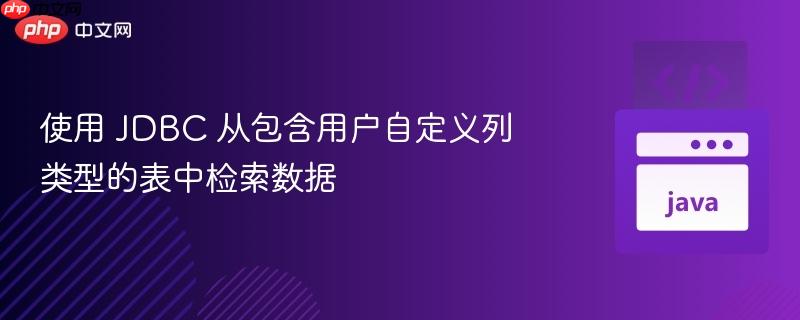
本文档旨在指导开发者如何使用 JDBC API 从数据库中检索包含用户自定义数据类型列的表中的数据。我们将探讨一种通过序列化自定义数据类型并将其存储到数据库中的方法,并提供相关代码示例和注意事项,帮助您有效地解决此类问题。
在使用 JDBC 从数据库中检索数据时,如果遇到包含用户自定义数据类型的列,直接使用 ResultSet 的 getObject() 方法可能无法正确获取数据。一种常见的解决方案是将自定义数据类型序列化后存储到数据库中,然后在读取时反序列化。
序列化自定义数据类型
序列化是将对象转换为字节流的过程,以便可以将其存储在数据库中或通过网络传输。Java 提供了 java.io.Serializable 接口来实现对象的序列化。
实现 Serializable 接口:
首先,确保您的自定义数据类型实现了 java.io.Serializable 接口。
import java.io.Serializable;
public class MyCustomType implements Serializable {
private static final long serialVersionUID = 1L; // 建议添加,用于版本控制
private String name;
private int value;
// 构造函数、getter 和 setter 方法
public MyCustomType(String name, int value) {
this.name = name;
this.value = value;
}
public String getName() {
return name;
}
public void setName(String name) {
this.name = name;
}
public int getValue() {
return value;
}
public void setValue(int value) {
this.value = value;
}
}序列化和反序列化:
使用 java.io.ObjectOutputStream 将对象序列化为字节数组,使用 java.io.ObjectInputStream 将字节数组反序列化为对象。
import java.io.*;
public class SerializationUtil {
public static byte[] serialize(Object obj) throws IOException {
ByteArrayOutputStream b = new ByteArrayOutputStream();
ObjectOutputStream o = new ObjectOutputStream(b);
o.writeObject(obj);
return b.toByteArray();
}
public static Object deserialize(byte[] bytes) throws IOException, ClassNotFoundException {
ByteArrayInputStream b = new ByteArrayInputStream(bytes);
ObjectInputStream o = new ObjectInputStream(b);
return o.readObject();
}
}在数据库中存储序列化数据
选择合适的列类型:
通常,使用 BLOB (Binary Large Object) 类型来存储序列化后的字节数组。

小型企业入门套件(The Small Business Starter Kit)提供了一个商业宣传网站的完整演示,他适合中小型企业。使用他创建的网站支持自定义模板,具有先进的功能,包括:内容和数据管理的SQL和XML数据源整合。该源码包含C#和VB两个版本,只有前台部分源码,微软官方截止到51aspx发布源码时还没有提供后台代码。小型企业网站入门套件的关键页面包括:产品分类显示新闻发布显示商户认证
 0
0

存储数据:
在将数据插入数据库之前,先将自定义对象序列化为字节数组,然后将其存储到 BLOB 列中。
import java.sql.*;
public class DatabaseExample {
public static void main(String[] args) {
String url = "jdbc:your_database_url"; // 替换为您的数据库 URL
String user = "your_username"; // 替换为您的用户名
String password = "your_password"; // 替换为您的密码
try (Connection connection = DriverManager.getConnection(url, user, password)) {
String insertQuery = "INSERT INTO report (NAME) VALUES (?)";
PreparedStatement preparedStatement = connection.prepareStatement(insertQuery);
// 创建自定义对象
MyCustomType customObject = new MyCustomType("Example Name", 123);
// 序列化对象
byte[] serializedData = SerializationUtil.serialize(customObject);
// 将序列化后的数据设置到 PreparedStatement 中
preparedStatement.setBytes(1, serializedData);
// 执行插入操作
preparedStatement.executeUpdate();
System.out.println("Data inserted successfully!");
} catch (SQLException | IOException e) {
e.printStackTrace();
}
}
}从数据库中检索并反序列化数据
检索 BLOB 数据:
使用 JDBC 从数据库中检索 BLOB 列的数据。
反序列化数据:
将检索到的字节数组反序列化为自定义对象。
import java.sql.*;
public class DatabaseExample {
public static void main(String[] args) {
String url = "jdbc:your_database_url"; // 替换为您的数据库 URL
String user = "your_username"; // 替换为您的用户名
String password = "your_password"; // 替换为您的密码
try (Connection connection = DriverManager.getConnection(url, user, password)) {
String selectQuery = "SELECT NAME FROM report WHERE id = ?"; // 假设有一个 id 列
PreparedStatement preparedStatement = connection.prepareStatement(selectQuery);
preparedStatement.setInt(1, 1); // 替换为您的 ID
ResultSet resultSet = preparedStatement.executeQuery();
if (resultSet.next()) {
// 获取 BLOB 数据
byte[] serializedData = resultSet.getBytes("NAME");
// 反序列化数据
MyCustomType customObject = (MyCustomType) SerializationUtil.deserialize(serializedData);
// 使用反序列化后的对象
System.out.println("Name: " + customObject.getName());
System.out.println("Value: " + customObject.getValue());
}
} catch (SQLException | IOException | ClassNotFoundException e) {
e.printStackTrace();
}
}
}注意事项
总结
通过将自定义数据类型序列化后存储到数据库中,可以有效地解决 JDBC 无法直接处理用户自定义列类型的问题。本文档提供了一种可行的解决方案,并提供了相关的代码示例和注意事项。在实际应用中,请根据具体情况选择合适的方案,并注意版本兼容性、性能和安全性等问题。
以上就是使用 JDBC 从包含用户自定义列类型的表中检索数据的详细内容,更多请关注php中文网其它相关文章!

每个人都需要一台速度更快、更稳定的 PC。随着时间的推移,垃圾文件、旧注册表数据和不必要的后台进程会占用资源并降低性能。幸运的是,许多工具可以让 Windows 保持平稳运行。

Copyright 2014-2025 https://www.php.cn/ All Rights Reserved | php.cn | 湘ICP备2023035733号